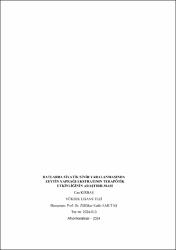| dc.contributor.advisor | Sarıtaş, Zülfikar Kadir | |
| dc.contributor.author | Kırbaş, Can | |
| dc.date.accessioned | 2024-04-17T06:49:21Z | |
| dc.date.available | 2024-04-17T06:49:21Z | |
| dc.date.issued | 12.03.2024 | en_US |
| dc.date.submitted | 2024-02-13 | |
| dc.identifier.uri | https://hdl.handle.net/11630/11403 | |
| dc.description.abstract | Yapılan çalışmada zeytin yaprağı ekstratının ratlardaki siyatik sinir hasarının üzerine etkisinin araştırılması amaçlanmıştır.
Çalışma 32 adet erişkin Wistar Albino ırk dişi rat üzerinde gerçekleştirildi. Denekler KONTROL, SHAM, ZY200 VE ZY400 gruplarına ayrıldı. Deneklere klinik değerlendirmeler için skin prick test, sinir fonksiyon analizi için walking track test ve EMG ölçümleri anestezi altında yapıldı. Çalışmanın ilk günü denekler kontrol grubu hariç olmak üzere anestezi altında operasyona alınarak, sağ bacaktaki siyatik sinirleri eksplore edildi. Eksplore edilen siyatik sinirlere bulldog klemp yardımıyla 60 saniye boyunca kompresyon uygulanarak siyatik sinir hasarı oluşturuldu. SHAM grubuna herhangi bir ilaç verilmedi, ZY200 grubuna 200 mg/kg/gün; ZY400 grubuna ise 400 mg/kg/gün doz ile zeytin yaprağı ekstratı gavaj yoluyla 8 hafta boyunca verildi. Çalışmanın sonunda ratlar sakrifiye edilerek histopatolojik, biyokimyasal ve hemotoloji yönünden değerlendirmeler yapıldı. Histopatolojik değerlendirmeler aksonal dejenerasyon, ödem ve vakuolizasyon yönünden değerlendirildi; ZY200 ve ZY400 gruplarının sonuçları KONTROL ve SHAM gruplarına oranla daha iyi olduğu görüldü ve istatiksel olarak anlamlı fark izlendi (p<0,05). Biyokimyasal değerlendirilmelerde NGF, TAS, TOS ve TGF-β1 yönünden değerlendirildi. ZY200 ve ZY400 gruplarının sonuçları SHAM ve KONTROL gruplarına göre daha iyi olduğu görüldü; NGF ve TOS değerlerinde anlamlı fark (p<0,05) izlenirken; TAS değerlerinde anlamlıya yakın fark (p=0,052) izlendi, TGF-β1 değerlerinde anlamlı fark izlenmedi (p=0,084). Klinik değerlendirmelerde skin prick test, sinir fonksiyon indeksi ve EMG ölçümlerinde anlamlı farklar izlenmiştir (p<0,05). Hematolojik değerlendirmelerde MID(%), MID, GRAN, RBC, MCV değerlerinde anlamlı farklar izlenmiştir (p<0,05). Sonuç olarak; zeytin yaprağı ekstratının siyatik sinir hasarı üzerinde iyileşmesine olumlu etkisi olduğu klinik, histopatolojik, biyokimyasal ve hematolojik incelemelerle ortaya konmuş olup daha ayrıntılı araştırmalara ihtiyaç olduğu kanısındayız. | en_US |
| dc.description.abstract | The aim of the study was to investigate the effect of olive leaf extract on sciatic nerve damage of rats. The investigation conducted on 32 adult female rats. Groups were divided into four groups as CONTROL, SHAM, ZY200 and ZY400. For clinical evaluations skin prick test, walking track test for sciatic functional index and EMG measurements performed on the subjects under anesthesia. The subjects applied general anesthesia on the first day with followed exploration of sciatic nerve on right legs of subjects except control group. The explorated sciatic nerves clembed with bulldog clamb for 60 seconds for make sciatic nerve injury. The SHAM group was not given any medication. 200 mg/kg/day to the ZY200 group; The ZY400 group was given olive leaf extract via gavage at a dose of 400 mg/kg/day for 8 weeks. At the end of the study, the rats were sacrificed, and histopathological, biochemical, and hematological evaluations were conducted. Histopathological evaluations were evaluated in terms of axonal degeneration, edema and vacuolization; The results of the ZY200 and ZY400 groups were seen to be better than the CONTROL and SHAM groups, and a statistically significant difference was observed (p <0.05). In the biochemical evaluations, NGF, TAS, TOS, and TGF-β1 were assessed. The results of the ZY200 and ZY400 groups were found to be superior to the SHAM and CONTROL groups. A significant difference (p<0.05) was observed in NGF and TOS values, and there was a nearly significant difference in TAS values (p = 0.052). However, no significant difference was observed in TGF-β1 values (p = 0.084). In clinical evaluations, significant differences were observed in skin prick test, nerve function index and EMG measurements (p <0.05). In hematogical evalutions, significant differences were observed in MID (%), MID, GRAN, RBC, MCV values (p<0,05). In conclusion; Clinical, histopathological, biochemical and hematological examinations have shown that olive leaf extract has a positive effect on the healing of sciatic nerve damage, and we believe that more detailed research is needed. | en_US |
| dc.description.sponsorship | Bu tez çalışması; Afyon Kocatepe Üniversitesi Bilimsel Proje Araştırmaları Koordinasyon Birimi (BAPK) Tarafından Desteklenmiştir.
23 SAĞ. BİL. 05 | en_US |
| dc.language.iso | tur | en_US |
| dc.publisher | Afyon Kocetepe Üniversitesi, Sağlık Bilimleri Enstitüsü | en_US |
| dc.rights | info:eu-repo/semantics/openAccess | en_US |
| dc.subject | Rat | en_US |
| dc.subject | Siyatik Sinir Hasarı | en_US |
| dc.subject | Zeytin Yaprağı Ekstratı | en_US |
| dc.title | Ratlarda siyatik sinir yaralanmasında zeytin yaprağı ekstratının terapötik etkinliğinin araştırılması | en_US |
| dc.title.alternative | Investıgatıon of the therapeutıc effectıveness of olıve leaf extrate on scıatıc nerve ınjury ın rats | en_US |
| dc.type | masterThesis | en_US |
| dc.department | Enstitüler, Sağlık Bilimleri Enstitüsü, Cerrahi Ana Bilim Dalı | en_US |
| dc.authorid | 0009-0001-5591-3972 | en_US |
| dc.relation.publicationcategory | Tez | en_US |



















